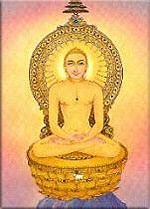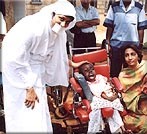| Living Tirthankara Mahavir’s Values |


The scene is set against a backdrop of a blue tropical sky that often quickly turned into a threatening mass of grey cloud. It was the seasons of the long rains.
The stage is the wonderful ‘Oshwal Centre’ a huge complex of modern halls and conference facilities that majestically stand in the west land suburbs of Nairobi, Kenya.

Over 600 delegates converged for what turned out to be an eventful, inspiring and purposeful International Jain Conference. The first encounters however, immediately established what was on their minds. They were apprehensive of the intentions of this gathering and unsure what was in store for them.

Surprisingly and to the amazement of the delegates, Nairobi looked like any other metropolis in the world. After lunch, the guests were registered and ‘matched’ with their hosts who rather unceremoniously shepherded them to their homes. The hosts would be responsible for their accommodation and transport for the duration of the conference. This was the birth of a novel concept of ‘home hospitality’ which for most cases turned out to be a home away from home, the basis to make friends and get the feel of the local flavour.

The first scene takes place on the evening of the 28th of April. The opening of the exhibition entitled ‘The Jain Spiritual Safari’ was a tribute to the local talent and creativity that went into making a wonderful Jain exhibition. Artistically modelled to give an African safari taste, the exhibition intricately explained various aspects of the Jain religion. Huge Rangolis also brought out the Jain message in beautiful shades of colour. Also, to commemorate the first conference on living Tirthankar Mahavir’s values, one hundred water wells were launched to assist the needy in the drought afflicted areas of Kenya, at a total cost of US.$1.0 million. All the guests were ecstatic with this sincere gesture of compassion in action.

The next morning set the scene for an open door Veerayatan meeting where various topical issues were addressed and debated. The opening ceremony scheduled for the evening set the mood for the things to come. The torch lighting ceremony, local native dances, speeches by dignitaries, prayer dance, an ‘African Welcome’ and the opening of the conference by the children of Kenya now began to promise an eventful weekend.

The next three days made up the essence of the conference. Lectures, interactive workshops and evening entertainment were the order of the day. Well renowned lecturer after lecturer took the stage and held the audience spell bound. Acharayaji planted the seed that sought an active action plan to embrace the needs of Jains. ‘Compassion in action’ is the common thread running through all the Jains, and should be the glue that unites us all. Dr. L. M. Singhvi stressed that Jainism is not negation of life, but the celebration of life and urged the youth to take up the challenge, pick up speed and take the concept global.

In a moving address, Sadhviji Shilapiji bravely addressed the issues facing our religion and stressed on the need for action now. Dr. Rupaben Shah proved popular with her addresses centred on family issues. Dr. N. P. Jain, a favourite amongst the environmentalists poetically conceptualised in our minds a heaven on earth. Dr. Atul Shah’s slide show portrayed Jainism in its artistic form. In an extremely tight time schedule, many other renowned lecturers, including respected Sadhvijis put forward their point of view and did battle with the master of ceremonies, affectionately called the Field Marshal, to scrape in a few extra minutes of delivery time.

The workshops provided the forum where the delegates, inspired by the lectures put forward their point of views and sought solutions to pertaining issues. Their specification was to come up with an action plan for the way forward. They went as far as appointing a world wide team of people with the specific task of implementing the suggestions made at the conference. The result put quite simply, requires the implementing team to link up a global infrastructure that can rapidly reach out to Jains all over the world. They need to come up with creative and interesting models that will encourage a wide audience of people to practice Thirthankara Mahavir’s values and also propagate an effective Jain teaching and learning system.
Each day concluded with evening programmes. Saturday celebrated the ‘Joys of Jain festivals’, a colourful and vibrant cultural event featuring local artistes. The eve of the final day featured a ‘Bhakti Bhavna’, a chorus of praise to our mentors and our religion. The final closing ceremony honoured the hundreds of volunteers who selflessly gave their time and effort to make this conference the success that it was. The warmth of the Kenyan hosts was overpowering and the delegates justly paid tribute to them.

The conclusion of the entire 4 day process was the creation of a task team with representatives from all parts of the world, who committed to ‘carry the torch’ forward and presented a plan for the delivery of the needs that arose from the different workshops. It was agreed that within a month there would be a lot of communication and action, to ensure that the euphoria created by the conference did not diminish, and to ensure that the efforts and time of some many people did not simply go into one big party, with no outcome.
Farewells were bid to the new relations that had evolved over the weekend. Not goodbyes, for new friendships and partnerships were forged whose frontiers can only be guessed, for destiny will set their limits. The organizers counted the delegates off the aero plane and counted them back on. And the curtain fell on a job well done.

The 400+ volunteers from the Jains of Nairobi and the team from Veerayatan, led by Acharyashree Chandanaji had succeeded in the mission of discovering a roadmap for the future of Jainism.
 Nilpa Shah
Nilpa Shah